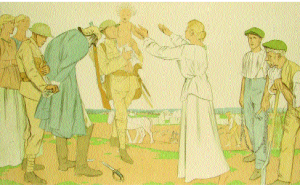Efforts and Ideals: images of World War I
Published in Editorial, Issue 5 (September/October), Volume 22
William Rothenstein’s ‘Triumph of Democracy’. (Dublin City Gallery: The Hugh Lane)
In 1917 the British Ministry of Information commissioned several well-known British artists to produce a series of images on different aspects of the First World War. The aim was to encourage a war-weary public and to raise support for the war effort. The images illustrate some of the changing attitudes at the time, such as towards the role of women in the war, the industry of war and the casualties of war. The lithographs were divided into two series. Twelve artists—including, amongst others, Augustus John, Edmund Dulac, Maurice Greiffenhagen and William Rothenstein—were commissioned to produce a single image each, representing the ‘Ideals’ for which the war was fought. The ‘Efforts’ series saw nine artists, including Christopher Wynne Nevinson, George Clausen, Eric Kennington, Frank Brangwyn, Claude Shepperson and A.S. Hartrick, produce six lithographs each on the war effort. The prospectus published on 1 January 1919 described the series as ‘a first attempt by a number of British artists, working in unison, to put on record some aspects of the activities called forth by the Great War, and Ideals by which those activities were inspired’.
This was the first war in which systematically produced government propaganda was aimed at the general public. The twelve images from the ‘Ideals’ series, most of which are in colour, are replete with symbolic imagery and use iconic, mythologised figures to depict specific subjects, such as the restoration of Serbia and the uniting of England and France against German aggression. Monumental female figures represent justice, strength and redemption, as in Francis Ernest Jackson’s image ‘United Defence against Aggression’. There are strong religious undertones in William Rothenstein’s ‘Triumph of Democracy’ (below), where a baby is held aloft by a soldier as his mother, clad entirely in white, holds up her hands to receive him. A German soldier, head bowed in submission, is held by another soldier. Some of the artists involved in the ‘Ideals’ series were official war artists. Augustus John, who was by then a well-known portrait artist, gained a commission in the Canadian Army as a war artist with the help of his friend Lord Beaverbrook. His war experience was less than satisfactory, however—the artist was involved in a brawl with a fellow officer and was sent home in disgrace after having spent only two months in France. His contribution to the ‘Ideals’ series is not his finest work.
The ‘Efforts’ series of images show the practicalities and preparations for war. Given the context of the images, it is to be expected that they make no allusion to the grim realities of the conflict, emphasis instead being placed on industry and activity. C.R.W. Nevinson was one of the most famous war artists during the First World War. At the outbreak of hostilities in 1914 he joined the Friends’ Ambulance Unit, tending to wounded French soldiers on the western front, but ill health forced him to return to Britain and he created a powerful series of Futurist paintings capturing the horrors and chaos of war. As a Futurist, Nevinson initially celebrated the violence and mechanised speed of the modern age but in his paintings of the trenches the soldiers are reduced to a series of angular planes and grey colouring. His lithographs for the ‘Efforts’ series avoid brutality and deal specifically with the building and use of aircraft in the conflict. His linear, dramatic descriptions, such as ‘Banking at 4,000 feet’ and ‘The Acetylene Welder’, are highly effective. The latter shows two women welding at a workbench, their bare arms and faces illuminated by the sparks.
Other official war artists were also confined to England, for health reasons or because of their age. George Clausen, who was in his sixties, was assigned to Woolwich Arsenal. His six images show the processes involved in making guns. Eric Kennington served in France from 1914 but was invalided out of the army in June 1915. He was an official war artist from 1916 to 1919. His lithographs focus on the training of soldiers and chart the experiences of a soldier from bayonet practice to the trenches. Frank Brangwyn’s images of sailors are startling in that the youth of some of those involved is so evident. Claude Shepperson’s ‘Tending the Wounded’ series show casualty clearing stations near the scene of fighting, but again, owing to the sketchy portrayal of the
casualties, the full horror and trauma of warfare are not apparent.
Archibald Standish Hartrick’s images of the work of women are striking, in particular the three that show the female munitions workers. The First World War was fought on a huge industrial scale; munitions were needed in vast quantities to feed the guns, and a variety of products were required to supply both military and civilian needs. With men recruited for the armed forces, the industrial workforce changed. Over 600,000 women took on previously male-dominated roles in industry during the war, working alongside men in reserved occupations. Women made an increasingly varied contribution, working in labs, mills and factories, sometimes in hazardous circumstances. The image of such women was far from clear-cut: whereas nurses were seen as ‘angels’, female munitions workers were simul-taneously depicted as capable of demanding physical labour and as compromising their maternal instincts. It was paradoxical that these women, who made the bullets and shells responsible for the deaths of so many, would also be the mothers of the next generation.
Margarita Cappock is Deputy Director and Head of Collections at Dublin City Gallery: The Hugh Lane and curator of this exhibition.
















